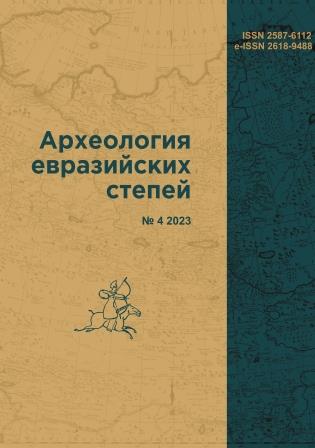Возможности применения метода ИК-Фурье спектроскопии для определения породы археологической древесины
DOI:
https://doi.org/10.24852/2587-6112.2023.4.90.94Ключевые слова:
археологические материалы, ИК-спектроскопия, нарушенное полное внутреннее отражение (НПВО), породы древесины, идентификация.Аннотация
Методом ИК-спектроскопии однократного нарушенного полного внутреннего отражения исследованы 53 образца древесины хвойных пород и 77 образцов древесины лиственных пород деревьев средней полосы России. Описаны характеристические полосы поглощения в ИК-спектрах, выявлены области полос поглощения, характерные для хвойных и лиственных пород древесины. Установлены характеристичные различия в спектрах хвойных и лиственных пород древесины, пригодные для их идентификации. С использованием установленных характеристичных различий идентифицированы породы древесины трех археологических материалов. Представлены результаты апробации предложенного ранее способа идентификации породы археологических древесных материалов методом ИК-спектроскопии однократного нарушенного полного внутреннего отражения. Показано, что для идентификации породы образцов археологической древесины наиболее перспективен диапазон 1270–1220 см–1, в котором обнаружены две полосы разной интенсивности. В спектрах хвойной древесины более интенсивная полоса расположена около 1265 см–1, а в спектрах лиственных пород – около 1230 см–1.
Библиографические ссылки
Bogolitsyn, K. G., Lunin, V. V. 2010. Fizicheskaya khimiya lignina (Physical chemistry of lignin). Moscow: “Akademkniga” Publ. (in Russian).
Khabarov, Yu. G., Pes’yakova, L. A. 2008. Analiticheskaya khimiya lignina (Analytical chemistry of lignin). Arkhangelsk: Arkhangelsk State Technical University (in Russian).
Khviyuzov, S. S., Bogolitsyn, K. G., Gusakova, M. A., Zubov, I. N. 2015. In Fundamental'nye issledovaniya (Fundamental Research) (9), 87–90 (in Russian).
Higuchi, T. 1997. Biochemistry and Molecular Biology of Wood. Berlin: Springer-Verlag.
Lin, S. Y. 1992. Methods in Lignin Chemistry C. W. Dence. Berlin: Springer-Verlag.
Picollo, M., Cavallo, E., Macchioni, N., Pignatelli, O., Pizzo, B., Santoni, I. 2011. In e-Pereservation Science (8), 23–28 (in English).
Traore, M., Kaal, J., Martinez, C.A. 2016. In Spectrochimica Acta Part A: Molecular and Biomolecular Spectroscopy. Vol. 153, 63–70 (in English).

Загрузки
Опубликован
Как цитировать
Выпуск
Раздел
Лицензия
Copyright (c) 2023 В.М. Пожидаев, Я.Э. Сергеева, С.Н. Малахов, Е.Б. Яцишина

Это произведение доступно по лицензии Creative Commons «Attribution-NonCommercial» («Атрибуция — Некоммерческое использование») 4.0 Всемирная.







